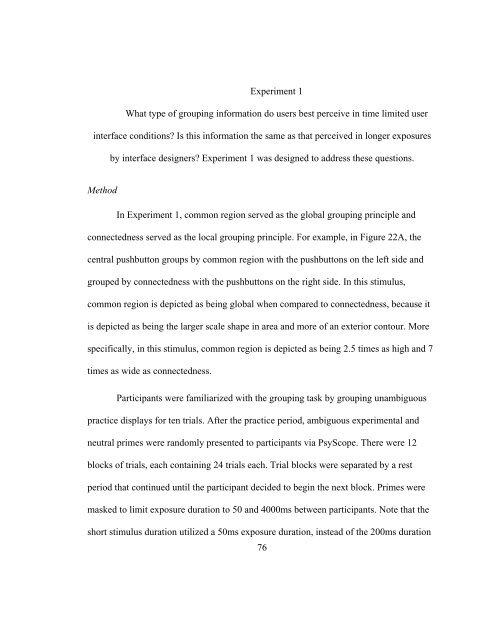The Use of Iambic Pentameter in the
The Use of Iambic Pentameter in the
The Use of Iambic Pentameter in the
You also want an ePaper? Increase the reach of your titles
YUMPU automatically turns print PDFs into web optimized ePapers that Google loves.
Experiment 1<br />
What type <strong>of</strong> group<strong>in</strong>g <strong>in</strong>formation do users best perceive <strong>in</strong> time limited user<br />
<strong>in</strong>terface conditions? Is this <strong>in</strong>formation <strong>the</strong> same as that perceived <strong>in</strong> longer exposures<br />
Method<br />
by <strong>in</strong>terface designers? Experiment 1 was designed to address <strong>the</strong>se questions.<br />
In Experiment 1, common region served as <strong>the</strong> global group<strong>in</strong>g pr<strong>in</strong>ciple and<br />
connectedness served as <strong>the</strong> local group<strong>in</strong>g pr<strong>in</strong>ciple. For example, <strong>in</strong> Figure 22A, <strong>the</strong><br />
central pushbutton groups by common region with <strong>the</strong> pushbuttons on <strong>the</strong> left side and<br />
grouped by connectedness with <strong>the</strong> pushbuttons on <strong>the</strong> right side. In this stimulus,<br />
common region is depicted as be<strong>in</strong>g global when compared to connectedness, because it<br />
is depicted as be<strong>in</strong>g <strong>the</strong> larger scale shape <strong>in</strong> area and more <strong>of</strong> an exterior contour. More<br />
specifically, <strong>in</strong> this stimulus, common region is depicted as be<strong>in</strong>g 2.5 times as high and 7<br />
times as wide as connectedness.<br />
Participants were familiarized with <strong>the</strong> group<strong>in</strong>g task by group<strong>in</strong>g unambiguous<br />
practice displays for ten trials. After <strong>the</strong> practice period, ambiguous experimental and<br />
neutral primes were randomly presented to participants via PsyScope. <strong>The</strong>re were 12<br />
blocks <strong>of</strong> trials, each conta<strong>in</strong><strong>in</strong>g 24 trials each. Trial blocks were separated by a rest<br />
period that cont<strong>in</strong>ued until <strong>the</strong> participant decided to beg<strong>in</strong> <strong>the</strong> next block. Primes were<br />
masked to limit exposure duration to 50 and 4000ms between participants. Note that <strong>the</strong><br />
short stimulus duration utilized a 50ms exposure duration, <strong>in</strong>stead <strong>of</strong> <strong>the</strong> 200ms duration<br />
76

















